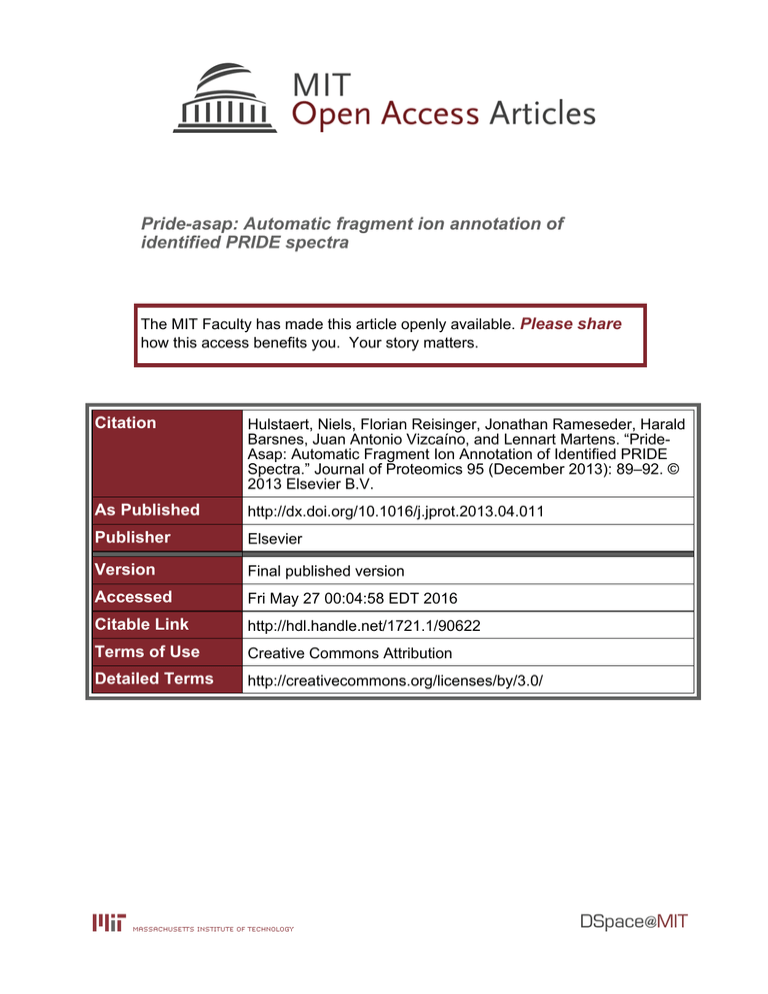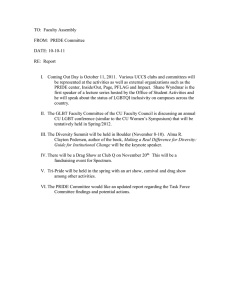
Pride-asap: Automatic fragment ion annotation of
identified PRIDE spectra
The MIT Faculty has made this article openly available. Please share
how this access benefits you. Your story matters.
Citation
Hulstaert, Niels, Florian Reisinger, Jonathan Rameseder, Harald
Barsnes, Juan Antonio Vizcaíno, and Lennart Martens. “PrideAsap: Automatic Fragment Ion Annotation of Identified PRIDE
Spectra.” Journal of Proteomics 95 (December 2013): 89–92. ©
2013 Elsevier B.V.
As Published
http://dx.doi.org/10.1016/j.jprot.2013.04.011
Publisher
Elsevier
Version
Final published version
Accessed
Fri May 27 00:04:58 EDT 2016
Citable Link
http://hdl.handle.net/1721.1/90622
Terms of Use
Creative Commons Attribution
Detailed Terms
http://creativecommons.org/licenses/by/3.0/
JO U R N A L OF P ROTE O MI CS 9 5 ( 20 1 3 ) 8 9–9 2
Available online at www.sciencedirect.com
ScienceDirect
www.elsevier.com/locate/jprot
Technical note
Pride-asap: Automatic fragment ion annotation of identified
PRIDE spectra☆
Niels Hulstaerta, b , Florian Reisingerc , Jonathan Ramesederd, e , Harald Barsnesf ,
Juan Antonio Vizcaínoc , Lennart Martensa, b,⁎
a
Department of Medical Protein Research, VIB, Ghent, Belgium
Department of Biochemistry, Ghent University, Ghent, Belgium
c
EMBL Outstation, European Bioinformatics Institute, Wellcome Trust Genome Campus, Hinxton, Cambridge, UK
d
Computational and Systems Biology Initiative, Massachusetts Institute of Technology, Cambridge, MA, USA
e
David H. Koch Institute for Integrative Cancer Research at MIT, Cambridge, MA, USA
f
Proteomics Unit, Department of Biomedicine, University of Bergen, Norway
b
AR TIC LE I N FO
Available online 17 April 2013
ABS TR ACT
We present an open source software application and library written in Java that provides a
uniform annotation of identified spectra stored in the PRIDE database. Pride-asap can be ran in a
Keywords:
command line mode for automated processing of multiple PRIDE experiments, but also has a
Proteomics
graphical user interface that allows end users to annotate the spectra in PRIDE experiments and
Bioinformatics
to inspect the results in detail. Pride-asap binaries, source code and additional information can
Mass spectrometry
be downloaded from http://pride-asa-pipeline.googlecode.com.
PRIDE
This article is part of a Special Issue entitled: Standardization and Quality Control in Proteomics.
© 2013 Elsevier B.V. All rights reserved.
The PRIDE (PRoteomics IDEntifications) database has been
collecting proteomics data for several years [1], displaying an
exponential growth curve. Over the life span of the PRIDE
database, the ability of the system to capture information has
increased dramatically, with the addition of (un-)identified mass
spectra in 2006 [2] and the storage of fragment ion annotation for
identified spectra since 2009 [3]. As a result of these incremental
updates, the data stored in PRIDE can vary substantially in the
level of annotation provided, both at the level of the peptide and
protein identifications, as well as with regard to the experimental meta-information. Even the emergence of tools that aid
and standardize data submission, notably the original PRIDE
Converter application [4] and the new PRIDE Converter 2 [5], has
not been able to fully do away with all existing issues.
One of the areas for improvement is the determination of
fragment ion annotation at the peptide-to-spectrum match
(PSM) level, which can help researchers to interpret their quality
and validity. Indeed, whereas some of the data processing APIs
used in PRIDE Converter and PRIDE Converter 2 can determine
this annotation based on the output of the search engine
(e.g., MascotDatfile [6] and OMSSA Parser [7]), it does not extract
such annotation from others (e.g., X!TandemParser [8]). Furthermore, the reported annotation can differ between these
different APIs, leading to substantial heterogeneity and thus
Abbreviations: API, application programming interface; asap, Automatic Spectrum Annotation Pipeline; GUI, graphical user interface;
PRIDE, PRoteomics IDEntifications (database); PSM, peptide spectrum match; PTM, post-translational modification.
☆ This article is part of a Special Issue entitled: Standardization and Quality Control in Proteomics.
⁎ Corresponding author at: Department of Medical Protein Research and Biochemistry, VIB and Faculty of Medicine and Health Sciences, Ghent
University, A. Baertsoenkaai 3, B-9000 Ghent, Belgium. Tel.: +32 92649458; fax: +32 92649484.
E-mail address: lennart.martens@vib-ugent.be (L. Martens).
1874-3919/$ – see front matter © 2013 Elsevier B.V. All rights reserved.
http://dx.doi.org/10.1016/j.jprot.2013.04.011
90
JO U R N A L OF PR O TE O MI CS 95 ( 20 1 3 ) 8 9 –92
search engine bias even when annotation is present. As a result,
mining PRIDE data for fragmentation characteristics for reuse
[9], analysis [10], or quality control [11] is currently a difficult
and error-prone enterprise, without any standardization.
In order to alleviate this issue, we here present pride-asap,
the automatic spectrum annotation pipeline that provides a
homogeneous a posteriori fragment ion annotation for PRIDE
data, regardless of origin or current annotation status. In
contrast to the recent work by Neuhauser et al. [12], pride-asap
does not seek to provide the most exhaustive possible annotation for a specific type of high mass accuracy MS/MS spectra, but
rather focuses on a rigorous and robust annotation that is
compatible with any fragmentation and instrument type, and
that will hold across very many independent experiments.
The pipeline uses the PRIDE public MySQL instance that is also
used by the PRIDE Inspector [11] as the source data repository. An
overview of the entire workflow is provided in Fig. 1. First, for a
given experiment, all originally submitted peptide identifications,
including any annotated post-translational modifications (PTMs),
are loaded. Then a mass recalibration step is performed to
determine possible systematic mass errors per considered charge
state. All identifications with a mass delta Δm within a defined
window of width 2ε, taken to reflect a suitable mass error for
the annotated instrument, are taken into account for this
recalibration.
jΔmj ¼ jme −mt j < ε
The next step in the pipeline attempts to explain each
remaining precursor mass deviation larger than ε by a combination of possible additional, user-specified post-translational
modifications. This step is particularly important for PRIDE
experiments submitted before 2008 (PRIDE accession numbers
below 9000), where the absence of a standard submission tool
often led to errors in the annotation of PTMs. A user-configurable
set of commonly encountered modifications is therefore
predefined on the pipeline level and can be combined with
the modifications found in PRIDE for the given experiment.
Modifications with equal mass delta signatures can be handled
by the pipeline, but they increase the combinatorial possibilities
significantly. After this step, one of three modification states
will be assigned to each peptide: (i) unmodified, the precursor
mass deviation is smaller than the allowed mass error;
(ii) modified, the mass deviation can be explained by a
combination of modification masses; or (iii) unexplained: the
mass deviation is significant but cannot be explained by any
modification combination.
The peptide sequence identifications are then re-matched
against their corresponding spectra. An adaptive noise filter
based upon iterative winsorization [13] is first applied to each
spectrum. This technique calculates a spectrum-specific noise
threshold value by iteratively reducing intensity outliers,
determined as any intensity outside the window centered on
the median with a width equal to twice the median absolute
deviation. The remaining ions in the filtered spectrum are
subsequently annotated, in turn allowing the peptide-tospectrum match to be scored. Annotation is performed by
matching calculated single and double charged b- and y-ions for
the precursor peptide sequence against the spectrum peaks.
The average fragment ion score is then defined as
savg ¼
Im
It
jP m j
where Im is the summed intensity of the matching peaks, It is
the total peak intensity and |Pm| is the number of matched
peaks. This score is primarily used to choose the best match for
the modified peptides where more than one possible combination or localization of modifications can be constructed for the
observed precursor mass deviation.
The final result of the pipeline can be directly visualized in the
graphical user interface (GUI, see Fig. 2), but will also be written
to two files. The first file contains the fragment ion annotations,
scores and spectrum metadata for all identifications in an
experiment. This tab-separated text file can later be re-imported
for visualization in the GUI or can be loaded into a downstream
data analysis program such as a spreadsheet or R [14] for further
analysis. The second file is formatted as XML and contains
the modifications used to explain the observed precursor mass
deviations. This file can also be re-imported into the pipeline GUI
Fig. 1 – Overview of pride-asap. Identifications and spectra are retrieved from the PRIDE public MySQL database, and processed
into three categories: unmodified, modified and unexplained spectra. The peptide sequences are then matched to the
corresponding spectra after adaptive noise filtering, and a score is derived for each peptide-to-spectrum match. The final
output of the tool consists of the complete list of annotated identifications and spectra, and the list of modifications used to
explain the observed precursor mass deviations in that experiment.
JO U R N A L OF P ROTE O MI CS 9 5 ( 20 1 3 ) 8 9–9 2
91
Fig. 2 – Screenshot of the pride-asap graphical user interface. (a) shows the list of annotated identifications (top) and the
annotated spectrum for the currently selected peptide-to-spectrum match. Note the indication of the noise threshold as a blue
shaded area. (b) shows the overview charts, that provide summary information on an experiment after annotation, including
the distribution of unmodified, modified and unmatched identifications, the mass deltas, b- and y-ion coverages, and the
fragment ion score distribution.
to serve as a fixed set of modifications for the annotation of
another experiment, if deemed appropriate. The pipeline can be
configured in detail through parameters accessible in the GUI, or
through a properties file for command line usage. The GUI also
provides the user with a concise overview of the resulting
annotations and their quality, through summary charts that
detail the mass deviations, modifications used and fragment ion
coverage statistics (Fig. 2b).
The pride-asap Java application is open source under the
permissive Apache2 license. The Spring 3 framework is used
for both for querying the PRIDE public MySQL instance as well
as for dependency injection, thus making the application
easily pluggable; all pipeline components are loosely coupled
by means of interfaces and can thus be replaced at will. This
is handled dynamically through two XML files, one for the
GUI and the other for command line mode, allowing new
implementations to be plugged in at load time.
The pipeline has already been used in production in two
recent studies [15] and [16], and has proven to be capable of
automatically processing more than a thousand PRIDE experiments without issues. The pride-asap pipeline will also allow
applications such as PRIDE Inspector to show uniform spectrum
annotations across all PRIDE experiments, and to guarantee
consistent visualization of protein and peptide identification
data loaded from the standard mzIdentML [17] format, where
the provision of fragment ion annotation is optional. It will also
provide a solid basis on which to build an a posteriori quality
control framework for the PRIDE database [18,19]. Additionally,
92
JO U R N A L OF PR O TE O MI CS 95 ( 20 1 3 ) 8 9 –92
the tool has now been included in the latest version of the
PRIDE Inspector tool [11] (version 1.3.0) as well, where it can be
used to retroactively annotate experiments from within PRIDE
Inspector.
N.H. and J.A.V. are funded by the ‘ProteomeXchange’ project
grant agreement number 260558, funded by the European Union
7th Framework Program. J.A.V. is also supported by the EU FP7
project ‘LipidomicNet’ [grant agreement number 202272]. F.R. is
supported by the Wellcome Trust [grant number WT085949MA].
J.R. is funded by the Howard Hughes Medical Institute International Student Research Fellowship. H.B. is supported by the
Research Council of Norway. L.M. acknowledges the support
of Ghent University (Multidisciplinary Research Partnership
“Bioinformatics: from nucleotides to networks”), and the
PRIME-XS project, grant agreement number 262067 funded by
the European Union 7th Framework Program.
The authors declare no conflict of interest.
REFERENCES
[1] Martens L, Hermjakob H, Jones P, Adamski M, Taylor C, States
D, et al. PRIDE: the proteomics identifications database.
Proteomics 2005;5:3537–45.
[2] Jones P, Cote RG, Martens L, Quinn AF, Taylor CF, Derache W,
et al. PRIDE: a public repository of protein and peptide
identifications for the proteomics community. Nucleic Acids
Res 2006;34:D659–63.
[3] Vizcaíno JA, Côté R, Reisinger F, Barsnes H, Foster JM,
Rameseder J, et al. The Proteomics Identifications database:
2010 update. Nucleic Acids Res 2010;38:D736–42.
[4] Barsnes H, Vizcaíno JA, Eidhammer I, Martens L. PRIDE
converter: making proteomics data-sharing easy. Nat
Biotechnol 2009;27:598–9.
[5] Côté RG, Griss J, Dianes JA, Wang R, Wright JC, van den Toorn
HWP, et al. The PRIDE Converter 2 framework: an improved
suite of tools to facilitate data submission to the PRIDE
database and the ProteomeXchange consortium. Mol Cell
Proteomics 2013 (in press).
[6] Helsens K, Martens L, Vandekerckhove J, Gevaert K.
MascotDatfile: an open-source library to fully parse and
analyse MASCOT MS/MS search results. Proteomics 2007;7:
364–6.
[7] Barsnes H, Huber S, Sickmann A, Eidhammer I, Martens L.
OMSSA Parser: an open-source library to parse and extract data
from OMSSA MS/MS search results. Proteomics 2009;9:3772–4.
[8] Muth T, Vaudel M, Barsnes H, Martens L, Sickmann A.
XTandem Parser: an open-source library to parse and analyse
X!Tandem MS/MS search results. Proteomics 2010;10:1522–4.
[9] Fan J, Mohareb F, Bond NJ, Lilley KS, Bessant C. MRMaid 2.0:
mining PRIDE for evidence-based SRM transitions. OMICS
2012;16:483–8.
[10] Barsnes H, Eidhammer I, Martens L. FragmentationAnalyzer:
an open-source tool to analyze MS/MS fragmentation data.
Proteomics 2010;10:1087–90.
[11] Wang R, Fabregat A, Ríos D, Ovelleiro D, Foster JM, Côté RG,
et al. PRIDE inspector: a tool to visualize and validate MS
proteomics data. Nat Biotechnol 2012;30:135–7.
[12] Neuhauser N, Michalski A, Cox J, Mann M. Expert system for
computer-assisted annotation of MS/MS spectra Mol Cell
Proteomics 2012;11:1500–9.
[13] Hasings C, Mosteller F, Tukey JW, Winsor CP. Low moments
for small samples: a comparative study of order statistics.
Ann Math Stat 1947;18:413–26.
[14] R Core Team. R: A Language and Environment for Statistical,
Computing; 2012.
[15] Gonnelli G, Hulstaert N, Degroeve S, Martens L. Towards a
human proteomics atlas. Anal Bioanal Chem 2012;404:1069–77.
[16] Volders P, Helsens K, Wang X, Menten B, Martens L, Gevaert K,
Vandesompele J, Mestdagh P. LNCipedia: a database for
annotated human lncRNA transcript sequences and structures
Nucleic Acids Res 2013;41:D246–51.
[17] Jones AR, Eisenacher M, Mayer G, Kohlbacher O, Siepen J,
Hubbard SJ, et al. The mzIdentML data standard for mass
spectrometry-based proteomics results. Mol Cell Proteomics
2012;11 (M111.014381).
[18] Foster JM, Degroeve S, Gatto L, Visser M, Wang R, Griss J, et al.
A posteriori quality control for the curation and reuse of
public proteomics data. Proteomics 2011;11:2182–94.
[19] Csordas A, Ovelleiro D, Wang R, Foster JM, Ríos D, Vizcaíno JA,
et al. PRIDE: quality control in a proteomics data repository.
Database (Oxford) 2012;11:bas004.








